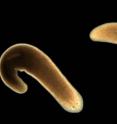International research team seeks to unravel flatworm regeneration
Planarian flatworms are only a few millimeters up to a few centimeters in length, live in freshwater and are the object of intense research, because they possess the extraordinary ability to regenerate lost tissue with the help of their stem cells (neoblasts) and even grow an entirely new worm out of minute amputated body parts. Now researchers from the Max Delbrück Center in Berlin, Germany together with researchers in the US and Canada present the first comprehensive catalogue of small RNAs of planaria, elements that regulate gene expression. They also have identified small RNAs which may play a role in regeneration and stem cell function, Nikolaus Rajewsky from the MDC points out (PNAS, Early Edition)*. Research suggests that the regeneration of the flatworm involves hundreds of genes. But how are these genes regulated? With the latest technologies researchers search for molecules which regulate genes, such as the small RNAs and especially microRNAs (miRNAs).
Of the hundreds of known planarian species the team of researchers from Germany, the US and Canada chose Schmidtea mediterranea. Full 30 percent of the cells of this species consists of stem cells, making it a unique model system to investigate the function of stem cells.
Many planaria genes resemble those of humans, and also many genes specifically linked to planarian stem cell biology and regeneration are conserved in humans. Understanding planarian regeneration therefore promises to yield important insights into human regeneration and stem cell biology, the researchers are convinced.
The researchers looked for small RNAs in stem cells as well as in the whole planarian organism. They discovered 60 new microRNA genes and could demonstrate that ten microRNAs are specifically linked to stem cell biology and may therefore play a role in regeneration. A few of these microRNAs also exist in humans.
Furthermore, the researchers discovered millions of piRNAs. This is a group of just recently discovered small RNA molecules which are important for the stability of the genome. The researchers could demonstrate that piRNAs are highly represented in the planarian stem cells and likely function in a similar way as in mammals.
Because stem cells are potentially immortal, they need to strictly control their genome integrity during transmission to future generations, and particulary to protect it against the uncontrolled propagation of mobile genetic elements, transposons. PiRNAs have been shown to selectively silence transposons in the fly and mouse genomes. Due to their analysis the researchers assume that piRNAs have a similar function in the planarian stem cells. Further studies are needed to investigate this.
Source: Helmholtz Association of German Research Centres
Other sources
- Unraveling Flatworm Regenerationfrom Science DailyTue, 21 Jul 2009, 15:35:18 UTC
- International research team seeks to unravel flatworm regenerationfrom PhysorgTue, 21 Jul 2009, 14:35:11 UTC
